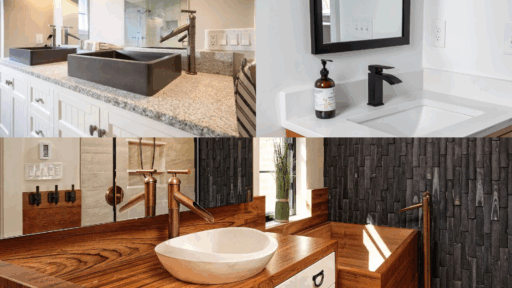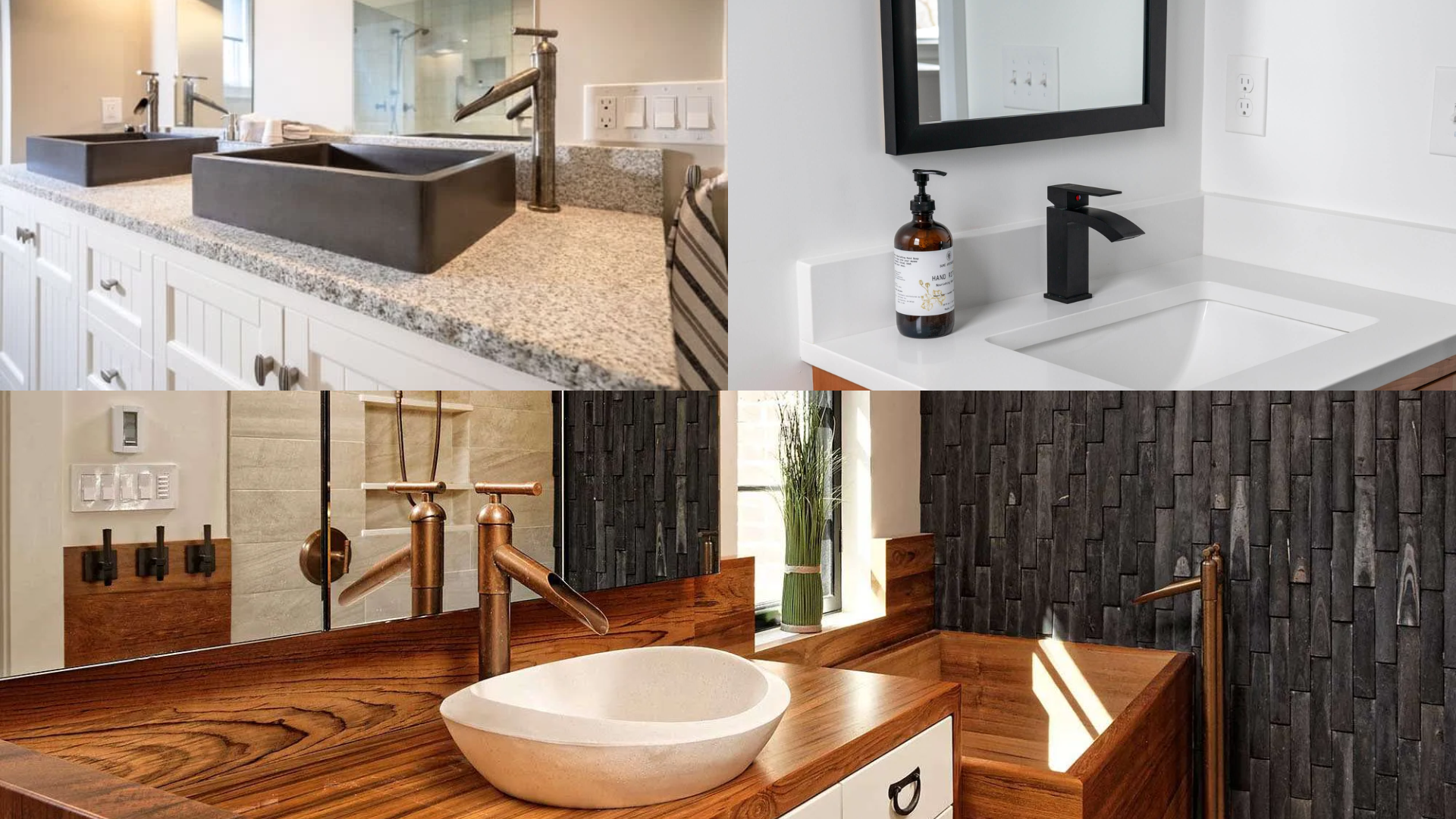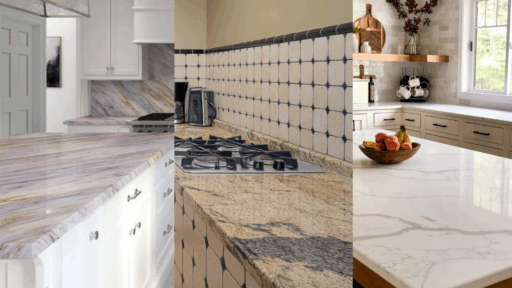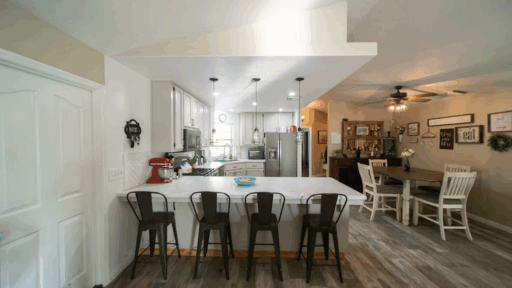When I remodeled my bathroom, picking the right countertop material felt like a bigger decision than I expected.
I wasn’t just looking for something that looked nice; I wanted a surface that could handle daily splashes, humidity, and the wear that comes with everyday use. I quickly learned that style, maintenance, and durability all play a role.
Some materials are tough but need sealing, while others offer a polished look with minimal upkeep. Then there’s the cost factor, which varies widely depending on the finish and installation.
Through my own research and experience, I found out which materials perform best in real-life bathrooms, not just in showrooms.
In this guide, I’ll walk you through the top bathroom countertop materials, compare their pros and cons, and help you figure out what will work best for your space, your needs, and your budget.
What to Consider When Choosing a Bathroom Countertop
Choosing the best bathroom countertop starts with understanding how you’ll use the space.
Bathrooms face constant moisture, heat, and everyday wear, so the surface needs to be both durable and water-resistant. Consider who uses the bathroom – kids, guests, or just you – as that affects how much wear it will face.
Here are the top points to guide your decision:
- Daily Use Needs: Pick a material suited to how often the bathroom is used.
- Moisture Resistance: Make sure it can handle humidity and splashes.
- Maintenance Level: Choose low-maintenance options if you prefer easy care.
- Style and Aesthetics: Match the material to your vanity, walls, and flooring.
- Scratch and Stain Resistance: Consider how well it handles spills and impact.
- Budget: Factor in both material and installation costs.
- Longevity: Select something that will look good for years to come.
- Feel and Texture: Some surfaces feel warmer, softer, or more natural.
- Installation Complexity: Some materials require professional help.
- Suitability for Space Size: In small baths, choose bold or minimal styles to define the space.
Balancing these factors will help you find a countertop that’s beautiful, practical, and perfect for your lifestyle.
Best Materials for Bathroom Countertops
These top countertop materials combine durability, water resistance, and visual appeal, each with unique strengths and style options.
1. Quartz
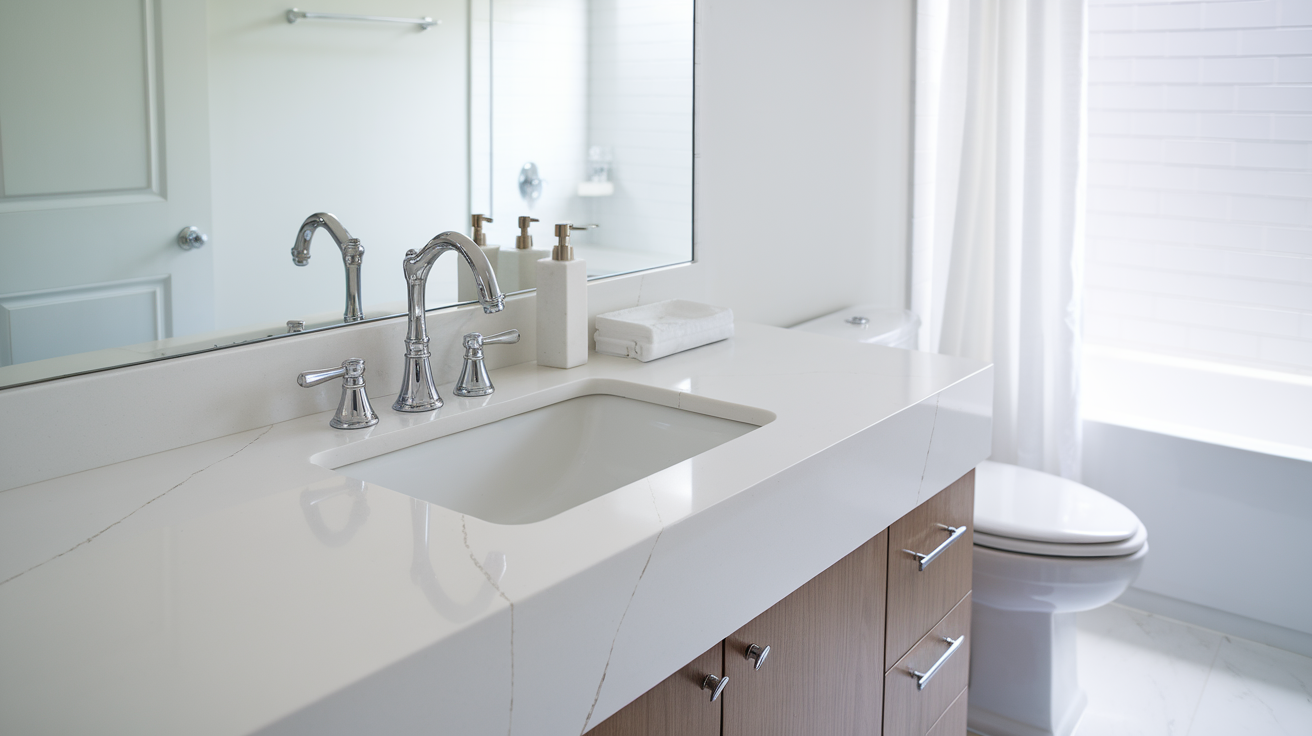
Quartz countertops are engineered from natural stone and resin, offering a non-porous, stain-resistant surface.
They’re easy to clean and don’t need sealing, making them ideal for busy bathrooms. Available in many colors and patterns, quartz mimics natural stone without the upkeep.
Its durability and low maintenance make it one of the most popular choices for long-term bathroom performance.
2. Granite
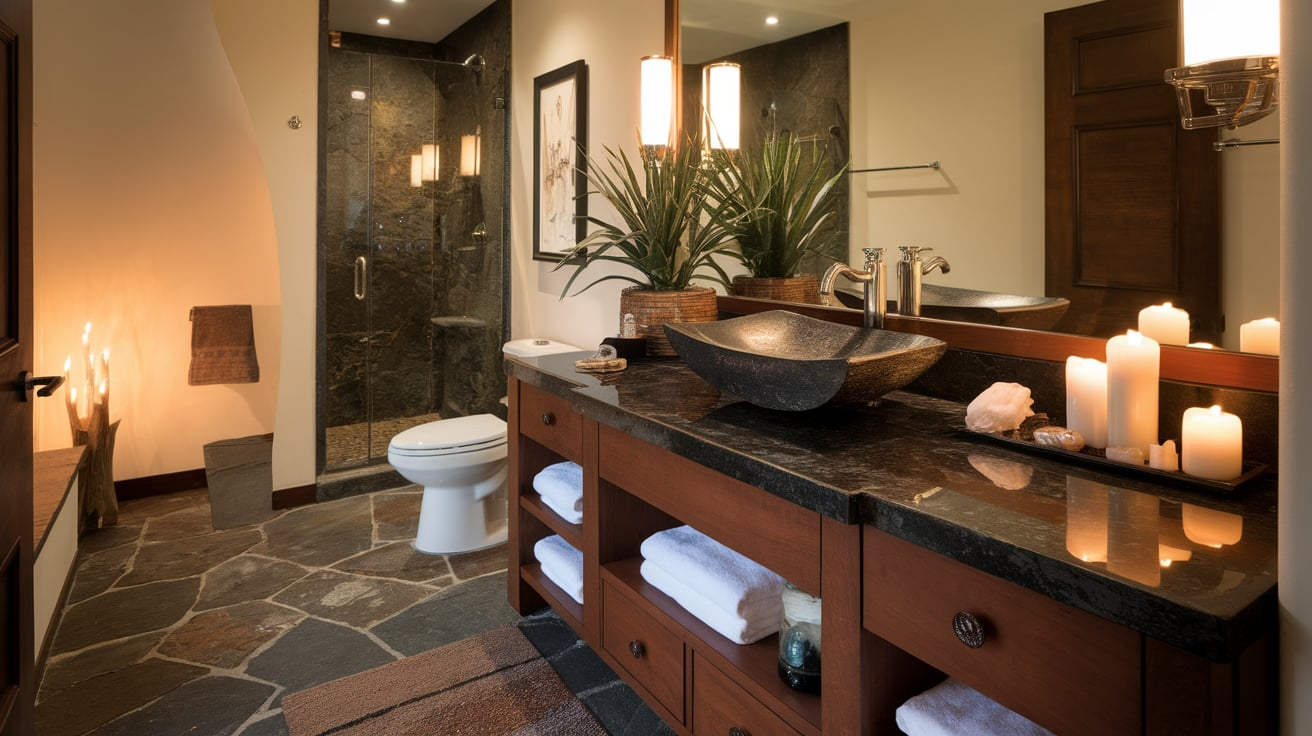
Granite is a natural stone known for its toughness and striking appearance. It resists moisture, heat, and scratches when properly sealed.
Each slab is unique, offering a one-of-a-kind countertop look.
Granite requires occasional resealing to maintain its finish, but its timeless style and high-end feel make it a popular pick for master bathrooms or upscale spaces.
3. Marble
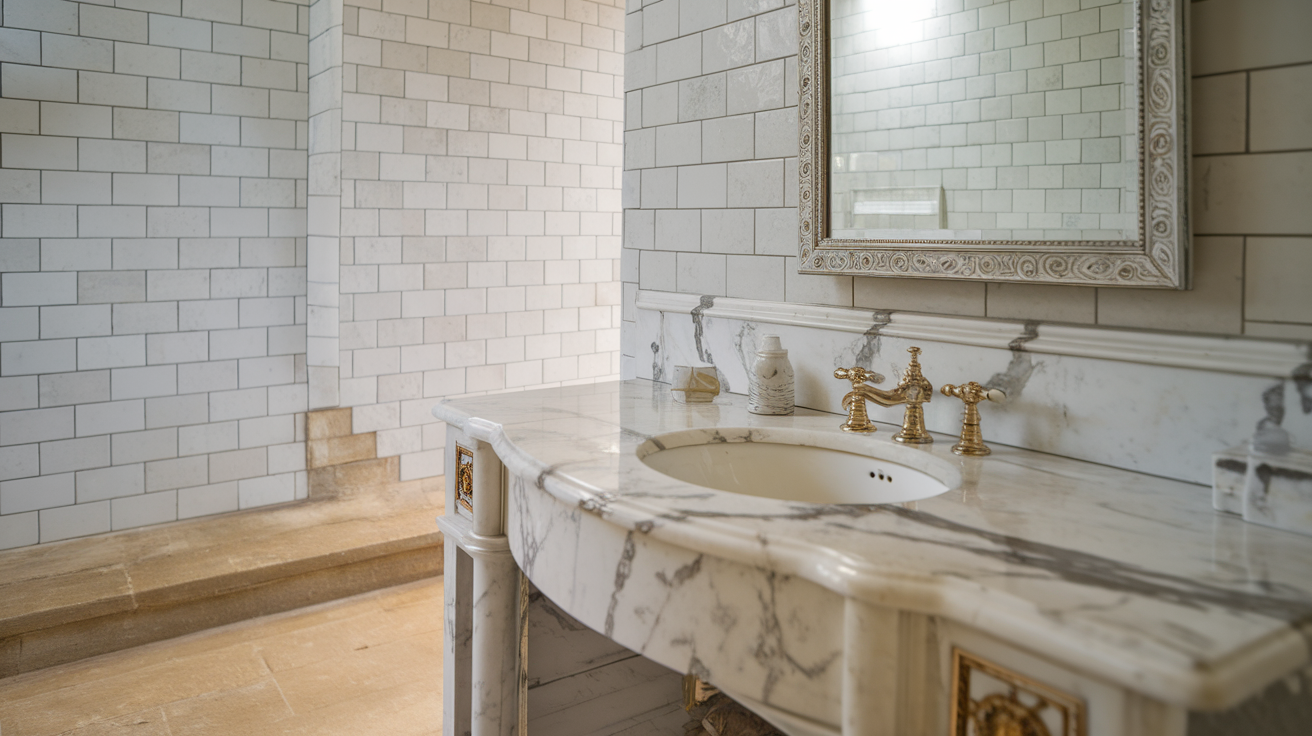
Marble brings elegance and a luxurious finish to any bathroom. Its smooth surface and natural veining are visually stunning, but it’s softer and more porous than other stones.
Marble can stain or scratch if not sealed and maintained carefully.
It’s a great choice for low-traffic bathrooms where style matters most, especially in classic or traditional designs.
4. Solid Surface (e.g., Corian)
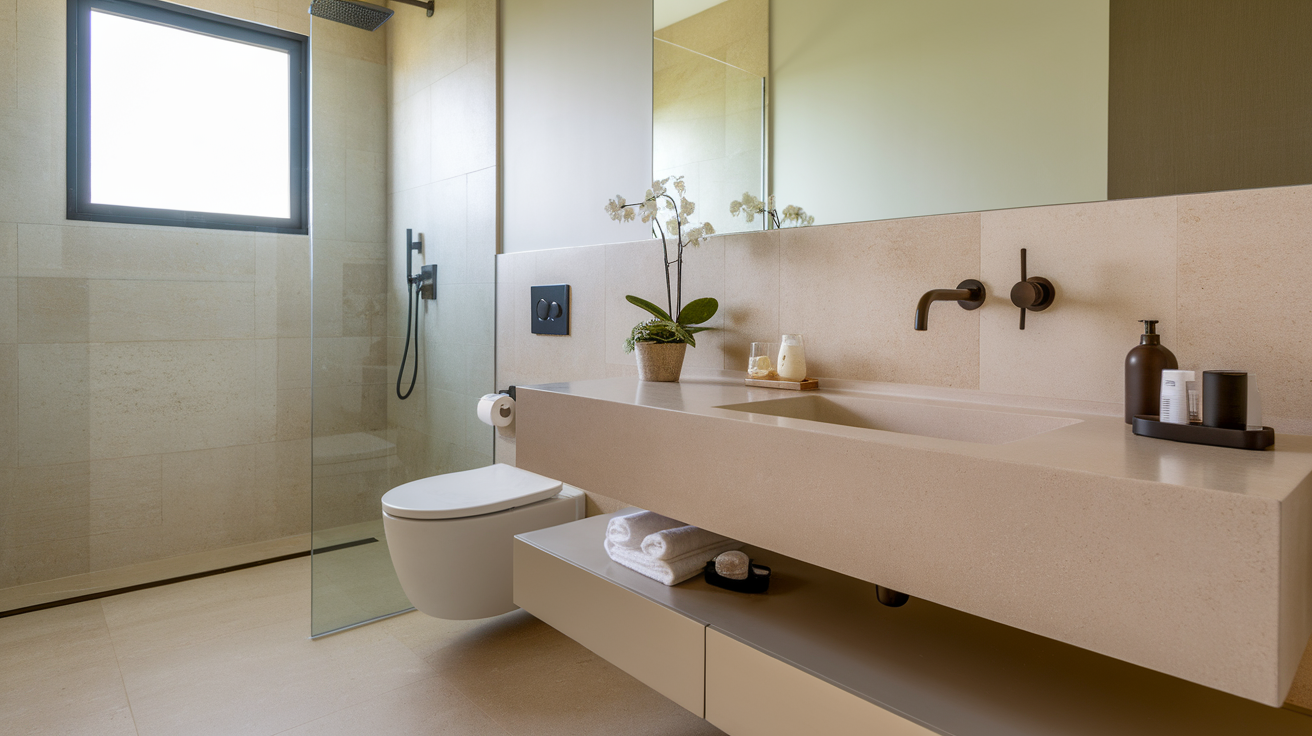
Solid surface countertops are made from acrylic and resin, offering a seamless and uniform appearance. They resist moisture and are easy to repair if scratched or chipped.
Though they’re not as heat-resistant as stone, they provide a sleek, modern look.
Integrated sinks are also possible, making cleanup simple. Solid surface is a practical choice for family bathrooms.
5. Laminate
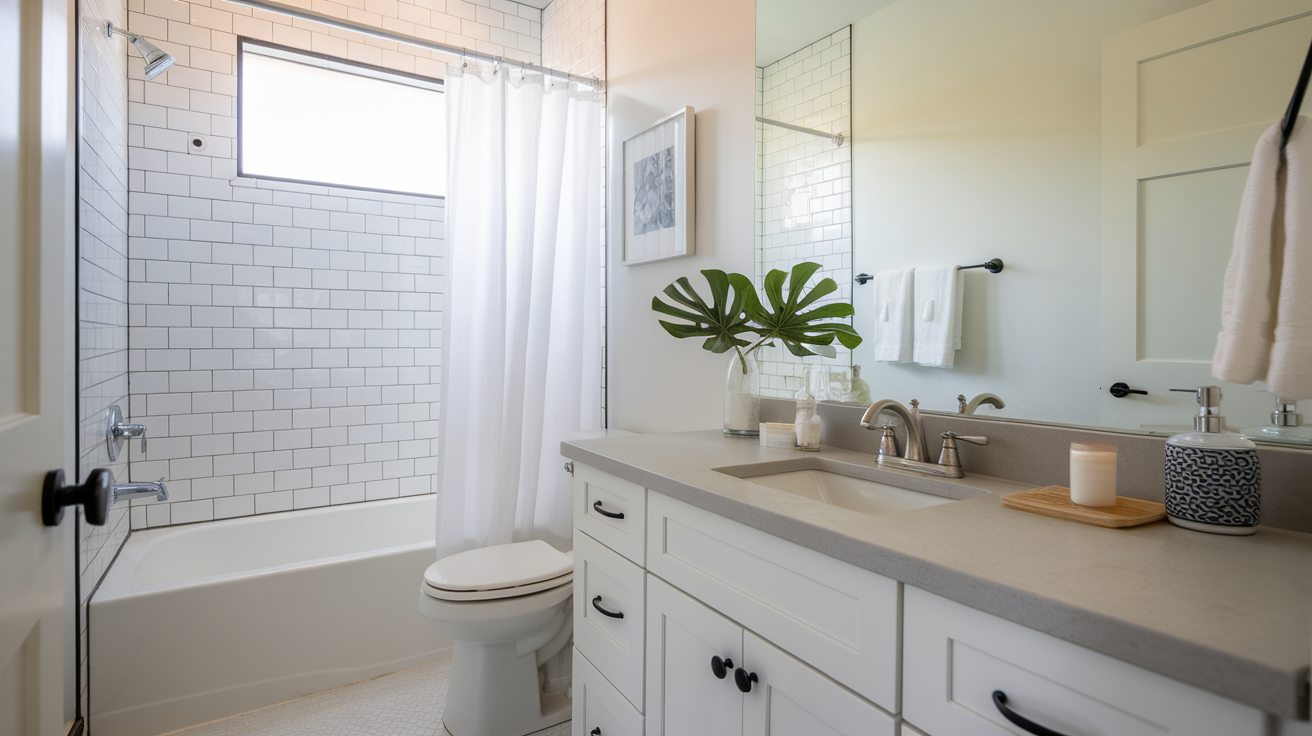
Laminate countertops are one of the most affordable options and come in a wide variety of colors and patterns. Modern versions can even mimic natural stone or wood.
While not as durable as stone, laminate resists water and is easy to install and clean. It’s a great choice for budget-friendly updates or guest bathrooms with lighter daily use.
6. Concrete
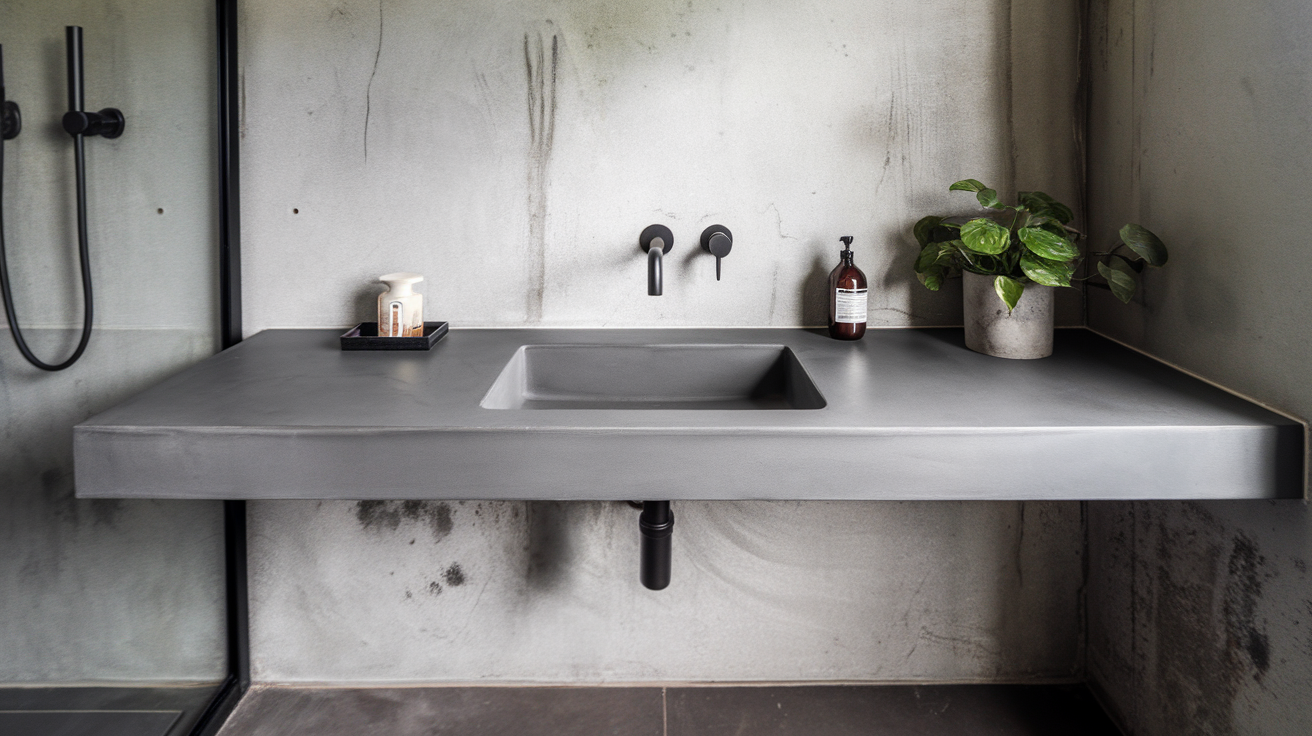
Concrete countertops offer a bold, modern look with the ability to be customized in shape, texture, and color. Sealed properly, they resist moisture and stains, though they may develop hairline cracks over time.
Concrete adds a unique industrial or contemporary touch to a bathroom and works well in both minimalist and artistic designs.
7. Tile
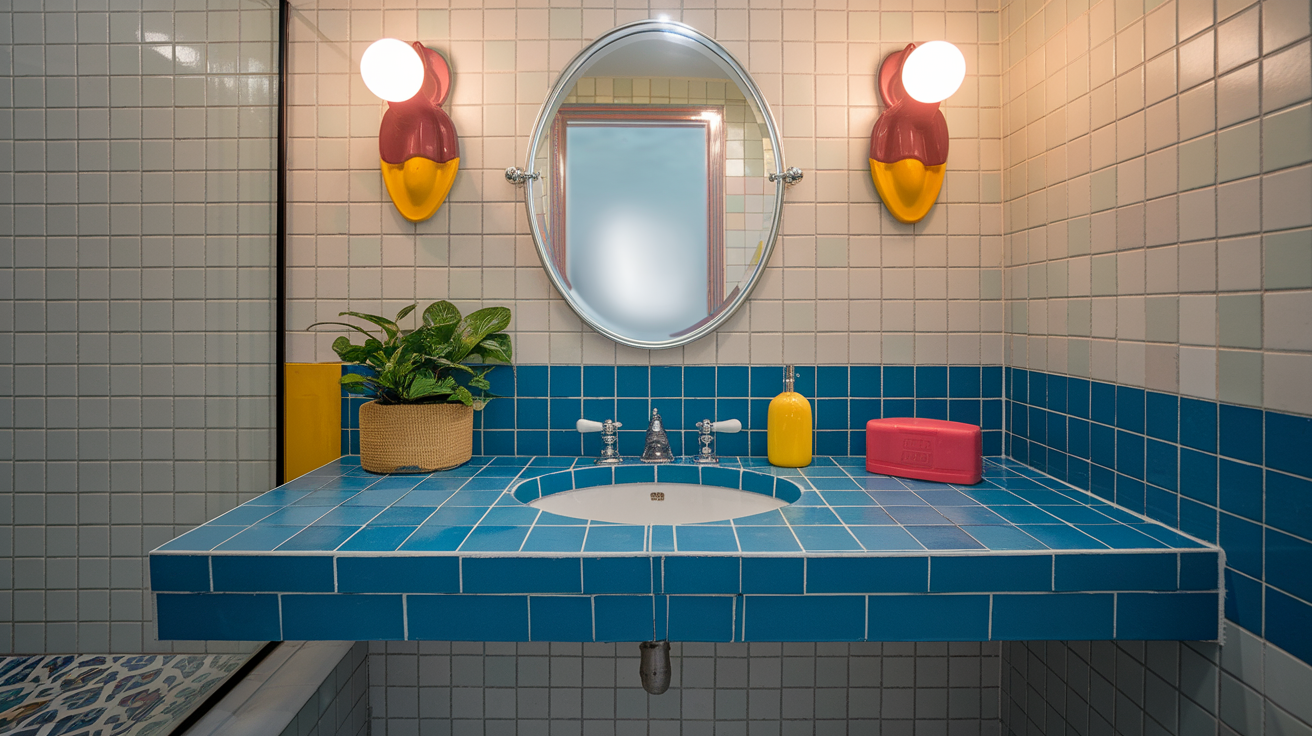
Tile countertops bring character and color to a bathroom with endless design possibilities.
Ceramic or porcelain tiles are water-resistant and budget-friendly. However, grout lines require regular sealing and cleaning to prevent mold and staining.
Tile is ideal for DIY projects or retro-inspired spaces, offering creativity and charm at a reasonable cost.
8. Wood
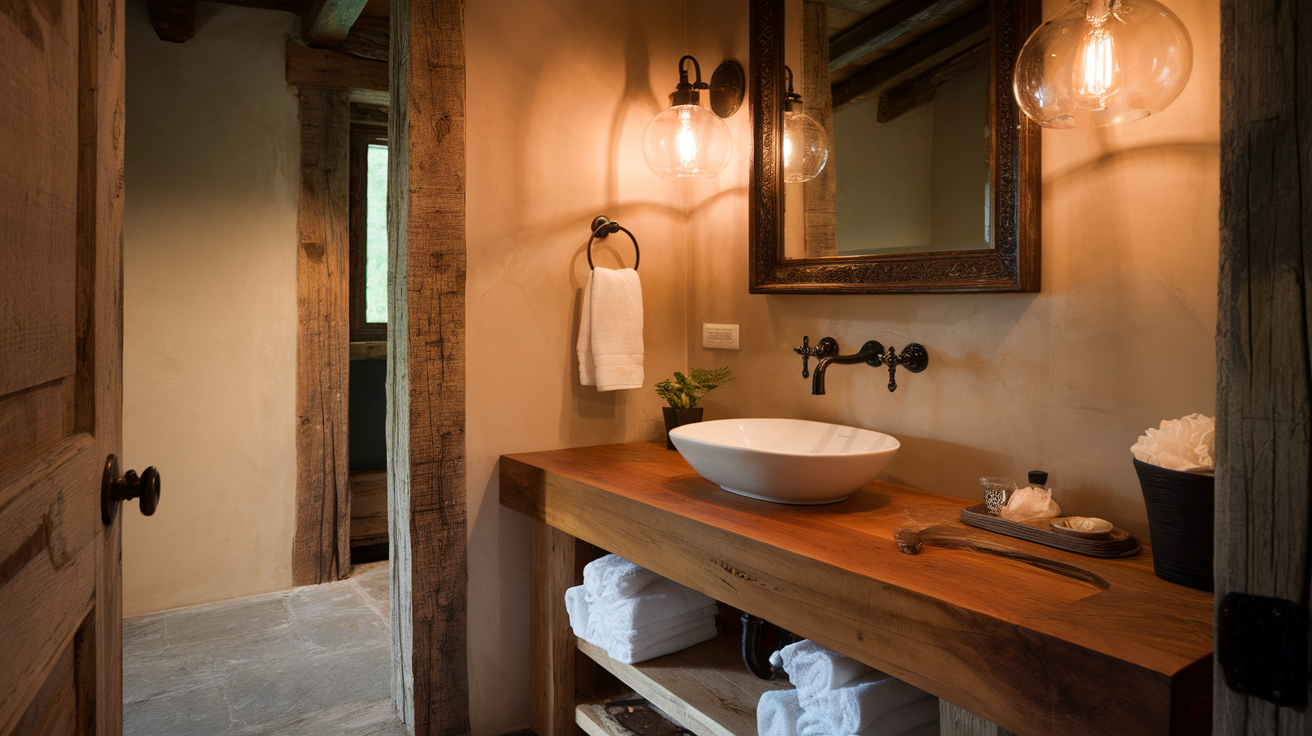
Wood countertops, like butcher block, offer warmth and a natural feel. When sealed properly, they resist moisture, though they require more care to avoid warping or staining.
Wood adds a rustic, cozy touch and works best in powder rooms or lightly used spaces. Re-oiling helps maintain the finish and keep it looking rich..
9. Glass
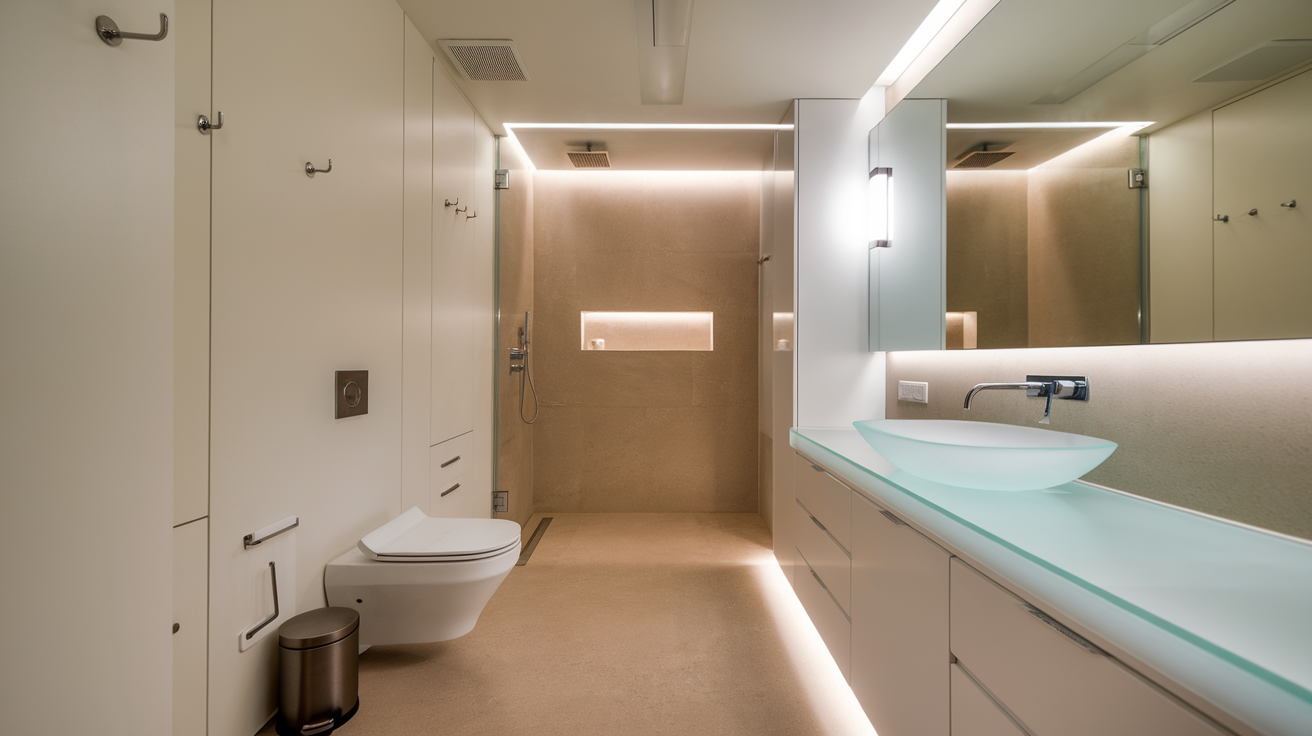
Glass countertops are sleek, modern, and naturally resistant to water and bacteria. They reflect light beautifully, adding brightness to smaller bathrooms.
Available in clear, frosted, or colored finishes, glass offers a clean and unique style.
Though it’s durable, it can show fingerprints and needs regular cleaning. It’s perfect for contemporary or spa-inspired designs.
Pros and Cons of Popular Countertop Materials
This table outlines the advantages and disadvantages of the most commonly used bathroom countertop materials to help you compare your options at a glance.
| Material | Pros | Cons |
|---|---|---|
| Quartz | Durable, low-maintenance, non-porous | Can be pricey, not heatproof |
| Granite | Natural look, very durable, resists heat and scratches | Requires sealing, heavy |
| Marble | Luxurious appearance, timeless style | Stains easily, needs regular sealing |
| Laminate | Budget-friendly, many styles available | Less durable, prone to damage from heat or moisture |
| Solid Surface | Seamless appearance, easy to repair | Can scratch or dent, not fully heat resistant |
| Concrete | Modern look, fully customizable | Needs sealing, prone to cracking over time |
| Wood | Warm and organic feel | Requires sealing, is sensitive to moisture, and scratches |
| Tile | Affordable, easy to customize | Grout can stain, and the surface may be uneven |
| Glass | Sleek and modern, easy to clean | Shows water spots, can chip or crack |
Which Is the Best Material for Bathroom Countertops?
The best material for a bathroom countertop depends on your lifestyle, budget, and design goals. For high-traffic bathrooms that need durability and minimal upkeep, quartz is often a top pick.
It’s non-porous, stain-resistant, and comes in many colors and patterns. Granite is another favorite for its natural beauty and strength, though it needs occasional sealing.
If style is your top priority, marble offers timeless elegance, but it requires careful maintenance to avoid staining and etching.
Laminate works well for budget-friendly projects, while solid surface offers a seamless, modern look at a mid-range cost.
Every material has trade-offs, so consider moisture resistance, daily wear, and cleaning needs when choosing. The goal is to balance function and design so your countertop stays beautiful and holds up over time.
Maintenance Tips for Long-Lasting Countertops
Keep bathroom countertops looking great for years with simple care routines and quick attention to spills or damage.
- Clean Regularly: Use a mild, non-abrasive cleaner and soft cloth to wipe down surfaces daily.
- Wipe Spills Quickly: Remove water, toothpaste, or cosmetic spills right away to prevent stains.
- Use Trays and Mats: Place trays under soap and toiletry containers to avoid surface damage.
- Avoid Harsh Chemicals: Skip bleach or acidic cleaners that can etch or discolor some materials.
- Seal When Needed: Granite, marble, and other porous surfaces should be sealed annually to maintain their resistance.
- Watch for Heat: Use trivets for hot styling tools to avoid heat marks on sensitive surfaces.
- Don’t Cut Directly: Always use a cutting board; direct knife use can scratch or damage the finish.
Conclusion
After researching and comparing different bathroom countertop materials, I’ve come to appreciate how much the right surface can elevate both function and style.
From durable quartz to elegant marble and affordable laminate, each option offers something unique depending on how the bathroom is used.
I’ve learned that it’s not just about the look, it’s about how the surface holds up to water, daily use, and cleaning routines.
If you’re planning your own bathroom upgrade, I hope this guide helps make your decision easier.
Think about your budget, the vibe you want, and how much time you’re willing to spend on upkeep.
Take your time comparing the pros and cons, and don’t forget to consider both beauty and durability.
Let me know which one you choose. I’d love to hear how it works out in your space.

